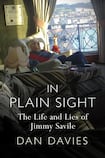
In 1972, I went on a charity walk from Dublin to Baldoyle, in aid of the Central Remedial Clinic. I would like to claim I did it out of pure beneficence, but the main attraction was that there was a rock concert at the end of it, featuring a much talked-about new band called Horslips. Leading the walk was, of course, the man off Top of the Pops, Jimmy Savile, wearing, if I remember rightly, a white shell suit open almost to the navel and a huge gold medallion bouncing off his hairy chest.
The odd thing, in retrospect, is that no one was in awe of this exotic creature from off the telly. He had, rather, a presence that was genuinely unique – a one-off compound of the hideously embarrassing, the acceptably freakish and the merely ubiquitous.
He had created for himself a niche of mundane weirdness. He was a living double take: the first glance told you there was something very, very strange about this man; the second reminded you that he was also utterly familiar. The second thought cancelled out the first. In its own sick way, this was a kind of genius – one of the great performative constructs of popular culture in the late 20th century.
Most psychopaths play at being “normal” and conceal their awful urges under a surface of ordinariness. This implies a narrative of eventual discovery: the evil will out. But Savile reversed the process, making – through the projective power of TV – his weirdness into a kind of normality.
Genius
The genius lay in the understanding that in this there was no narrative of eventual discovery: the evil is already out. Let’s remember that it worked: Savile was dead before he was “caught”. On his death, the BBC hailed him as a great popular entertainer and he was buried by the Catholic bishop of Leeds with a guard of honour of Royal Marines. Savile won.
In Dan Davies’s gripping book about this “entertainer” and serial sex criminal, he recounts a story Savile liked to tell about his time as a coal miner in South Kirby. (He was a “Bevan Boy” doing wartime work to replace men at the front.) He once accidentally arrived late for work dressed in his suit, so late that he had to go down the pit in his Sunday best. He stripped naked and wrapped his suit in his newspaper. In the evening he washed his hands and face in his canteen water and emerged from the pit looking immaculate in his dapper clothes. The effect on his fellow miners, he said, was “electric”: “I just realised that going back clean would freak people out, and it did. Underneath the clothes I was black as night. But I realised that being a bit odd meant that there could be a payday.”
The metaphor is almost too readily available: clean on the outside, black as night underneath, relishing the power of oddness. But it doesn't quite get the true nature of Savile's persona. In his celebrity pomp he didn't, of course, wear good clothes – he paraded around in those hideous shell suits. And he didn't really cover up the blackness either. Part of the thrill of being Jimmy Savile was the way the nasty bits were allowed to dangle out there in public view, as if he was constantly daring someone to point them out. Savile played out a version of the Emperor's New Clothes, in which no one dared to point out the obvious. The twist was that Savile wasn't, like the emperor in Hans Christian Anderson's story, a dupe but rather the orchestrator of the whole act.
Mainstream entertainers trade on an image of ordinariness – they are supernormal rather than abnormal. Savile, by contrast, was nakedly screwed up, and not in a comically neurotic, zany way. While other “personalities” traded on empathy, Savile’s psychopathic detachment from human feelings was literally played out in public.
Malaise
In 1991, when Anthony Clare interviewed him for his radio series In the Psychiatrists's Chair, he wrote of being struck by Savile's "emphasis on money and a denial of feelings". Clare noted "a profound psychological malaise" in Savile. He more than hinted at the necrophilia that has now been revealed to be among his perversions, characterising Savile as one of those who "see life as incorrigibly messy and death as a frozen model of perfection" and who are "half in love with death".
Savile seems to have derived a perverse pleasure from hinting at his own monstrousness – presumably it gave him a paradoxical sense of impunity and power.
When Louis Theroux asked him if he’d been following the Myra Hindley story (Hindley, the Moors murderer, was dying at the time), Savile replied, “I am the Myra Hindley story.” When Clare asked him why he had bought 17 Rolls Royces, he replied (on air, remember) that, “If a scandal comes up . . . you’re finished.”
He got a thrill from catch-me-if-you-can flirtation with exposure, telling Davies, who interviewed him over a seven-year period, that “I’m like a piece of soap in the bath; you can see it but when you try to get hold of it, it’s gone.”
And Savile stays gone, even in Davies’s often brilliant book. The darkness at the heart of Savile’s crimes is not, in the end, capable of being illuminated, even by a work as detailed, scrupulous and assiduous as this.
Allegations
There are some reasons to think that he may have been sexually abused: certainly, sexual violence and exploitation run in his family. His older brother, Johnnie, lost his job at a mental hospital (where his role in “entertainments” was eerily similar to Jimmy’s in Broadmoor) after allegations that he sexually assaulted a patient. In 1986, Savile’s nephew was sentenced to four years in prison for sexually assaulting a 14-year-old girl.
Whatever happened to Savile, it combined with celebrity culture, the craven indulgence of power and warped notions of sexual liberation to forge a creature with an impregnable sense of entitlement to do whatever he wanted.
But not to just anyone.
Savile chose the weak and vulnerable – children and mental hospital inmates. Around the lurid and astonishing tale that Davies tells so well is the old familiar silence of victims who could not make themselves heard and institutions that did not want to know. In that sense, too, Savile remains weirdly ordinary and strangely familiar.











